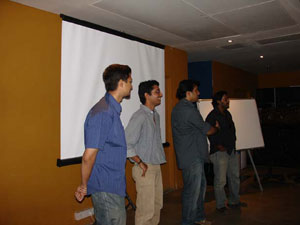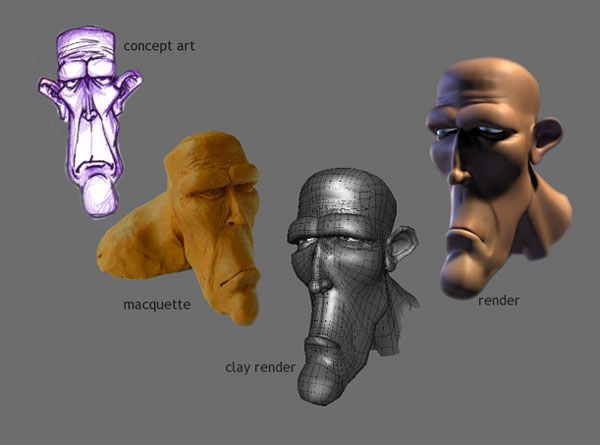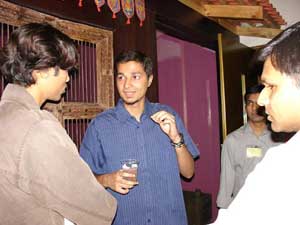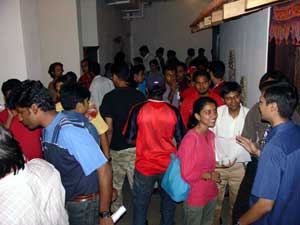The monthly “CG Meetup @ R&H India” once again got an overwhelming response from the Mumbai CG Industry. February’s session was one that was conducted as full modeling workshop, and registrations for the event reached capacity very soon after the announcement of the event.
 “We had to limit attendees to around 130 individuals and unfortunately we had to turn away the rest of the over 200 people that wrote to us to register the for the event”, said Prashant Buyyala of Rhythm & Hues India. The success of this event once again demonstrated the significant thirst for knowledge and information sharing that exists within the Indian CG Industry and has further energized organizations like ASIFA India, CGTantra and Animation Xpress and Rhythm & Hues India who organized the modeling workshop to rise to meet this demand.
“We had to limit attendees to around 130 individuals and unfortunately we had to turn away the rest of the over 200 people that wrote to us to register the for the event”, said Prashant Buyyala of Rhythm & Hues India. The success of this event once again demonstrated the significant thirst for knowledge and information sharing that exists within the Indian CG Industry and has further energized organizations like ASIFA India, CGTantra and Animation Xpress and Rhythm & Hues India who organized the modeling workshop to rise to meet this demand.
The modeling workshop, was conducted by industry professionals, Vivek Ram (R&H India), Madhu Nair (UTV Toons), Carl Castellino (Future Thought), and Dileep Varma (R&H India). The five hour workshop was very well organized and it covered a variety of topics that delved into the intricacies of 3D modeling.
After the initial introductions, Vivek Ram started the workshop with its first session that dealt with the various types of modeling used in studios in India and abroad. A brief overview was given about techniques such as Polygon Modeling, NURBS Modeling, SubDivision, MetaBall and Zbrush modeling. Technicalities concerned with 3d Scanning and Photomodeling techniques, which as still fairly new in India, were also mentioned during this session.
Dileep’s session was up next where he gave an overview of the entire journey of a model from a concept on paper to the screen. He emphasised on the importance of preproduction for a modeler in the form of drawings and maquettes. To explain the procedures in a better fashion, he took the audience through a case study of “Chacko”, a character designed and modeled by himself. He explained how the character was developed through various rounds of sketches and how before modeling, a clay maquette was also created for a better understanding of form.
He then showed the creation of the 3D model in its various stages. He spoke about how the modeling department was connected to all the other departments in production and therefore had to be really efficient in planning their work. He also touched the topic of UV mapping as a parallel process while modeling. His session finally ended with a small animation of Chacko.
This session laid the ground for the sessions to come and generated a lot of questions from the audience which were jotted down to be answered as the sessions proceeded.
Carl took over for the next session with dealt with the technicalities of modeling. He started with basic introduction to the various terms used in everyday modeling, such as Tris, Quads, Ngons and Edge Loops. With the help of examples, he explained how these were used in various parts of the model and how they affected smoothened surfaces. This session dealt with the various technical problems that came with placing Tris and Ngons in various areas of the model such as joints and round surfaces and how each of them had a different affect on the final output. He also answered questions related to how smoothing worked on a mesh and the necessity of optimised geometry. This session ended with Vivek giving a list of bad geometry and Dos and Don’ts in a production pipeline.
After this, there was a brief interval during which the attendees had a great opportunity to walk around R&H India’s facility, meet colleagues from the industry, and in general network with several other passionate individuals.
The post interval session kicked off with Madhu introducing Hard Surface modeling to the audience. He dived right in with his case study of a Mercedes car. He spoke about general methods used for hard surface modeling in the industry and the pros and cons of each method used. He highlighted the mistakes made by amateur modelers and how certain work flows helped improve the efficiency and the output of a modeler. Madhu elaborated on the differences between the workflow for an organic modeler and a hard surface modeler. He also spoke on how various types of geometry affected the texture on a surface and how it was necessary to model only those parts that were visible in the camera and not to go beyond a certain amount of detail. He concluded his session by again talking about optimization in hard surface modeling.
Vivek took over from here with his session that dealt with the aesthetics of modeling. He opened his session by asking the students various questions about what they knew about modeling. He then explained how 3D modeling was to be seen more as an art than a technique. He stated that modeling wasn’t a software specific process and hence limited tools could help one be a modeler if he approached it like a sculptor. The importance of pre-production and research was emphasised over and over in this session. He spoke about how modeling in passes and using a large bank of references to study can help one be a very efficient and good modeler. Using a few models done by 2 volunteers, Prachi and Anisha, he elaborated on the use of proxy models for a good understanding of form.

He then went into an in depth study of form and volume using a Warrior model, designed and modeled by himself. During this session he explained how the technicalities that were discussed earlier were complimentary to aesthetics and not a different faculty. He summed up this session by answering questions that were left on the board. These questions were again answered with a repetitive emphasis on study of anatomy and the use of references.
Carl came back in after this hour long session, with case studies of modeling body parts such as the hand, the leg, the face and the ear. These were common problem areas for a lot of modelers, students and professionals alike and hence was covered extensively with examples of various stages with frequent doses of humor. His session was a perfect finale as it touched on the points discussed in all the earlier sessions. He also mentioned the necessity for constant reviews and critics given by colleagues or fellow artists both online and offline.
The topic of modeling for technicalities such as dynamics, fur and cloth was kept as an open discussion and hence information was freely shared by all the presenters and the seniors in the crowd. Akash from Prana was significantly helpful here by sharing his experience on modeling for fur, in a lot of projects.
 Demo reel dos and don’ts were then discussed which proved very helpful for the students. The conductors mentioned common flaws in modeling demo reels that they came across in their careers and how wireframes were a must for a modeling show reel. Prashant and Prasad from Rhythm & Hues India chipped in here with their experiences on reviewing demo reels and shared some helpful guidelines on how to make the best impressions with a demo reel.
Demo reel dos and don’ts were then discussed which proved very helpful for the students. The conductors mentioned common flaws in modeling demo reels that they came across in their careers and how wireframes were a must for a modeling show reel. Prashant and Prasad from Rhythm & Hues India chipped in here with their experiences on reviewing demo reels and shared some helpful guidelines on how to make the best impressions with a demo reel.
The evening ended with an open mic session, as is customary for all the CG Meetups at Rhythm & Hues India. A few people used the opportunity to show their work to a live audience and various announcements concerning upcoming workshops and events were made.
 All in all, the workshop strived to give people an overview of the various aspects of modeling and laid the ground for more in depth workshops on each session. Prashant Buyyala of Rhythm & Hues India summarized to the audience that “this workshop was truly wonderful and has raised the bar for all future CG meetups at Rhythm & Hues”. Months of preparation went into this workshop to provide just the necessary amount of information in the given time, so as to cater to an audience of different skill levels and to maintain the flow of a workshop that was to span over hours. In the end, both the audience and the organizers seemed happy with how things turned out at the end of the day.
All in all, the workshop strived to give people an overview of the various aspects of modeling and laid the ground for more in depth workshops on each session. Prashant Buyyala of Rhythm & Hues India summarized to the audience that “this workshop was truly wonderful and has raised the bar for all future CG meetups at Rhythm & Hues”. Months of preparation went into this workshop to provide just the necessary amount of information in the given time, so as to cater to an audience of different skill levels and to maintain the flow of a workshop that was to span over hours. In the end, both the audience and the organizers seemed happy with how things turned out at the end of the day.
The “CG Meetup @ R&H India” team is busily working on the details of the next monthly session which will be conducted on Saturday, March 25th 2006. The announcement with the details of the event will be made within the next week so stay tuned.

